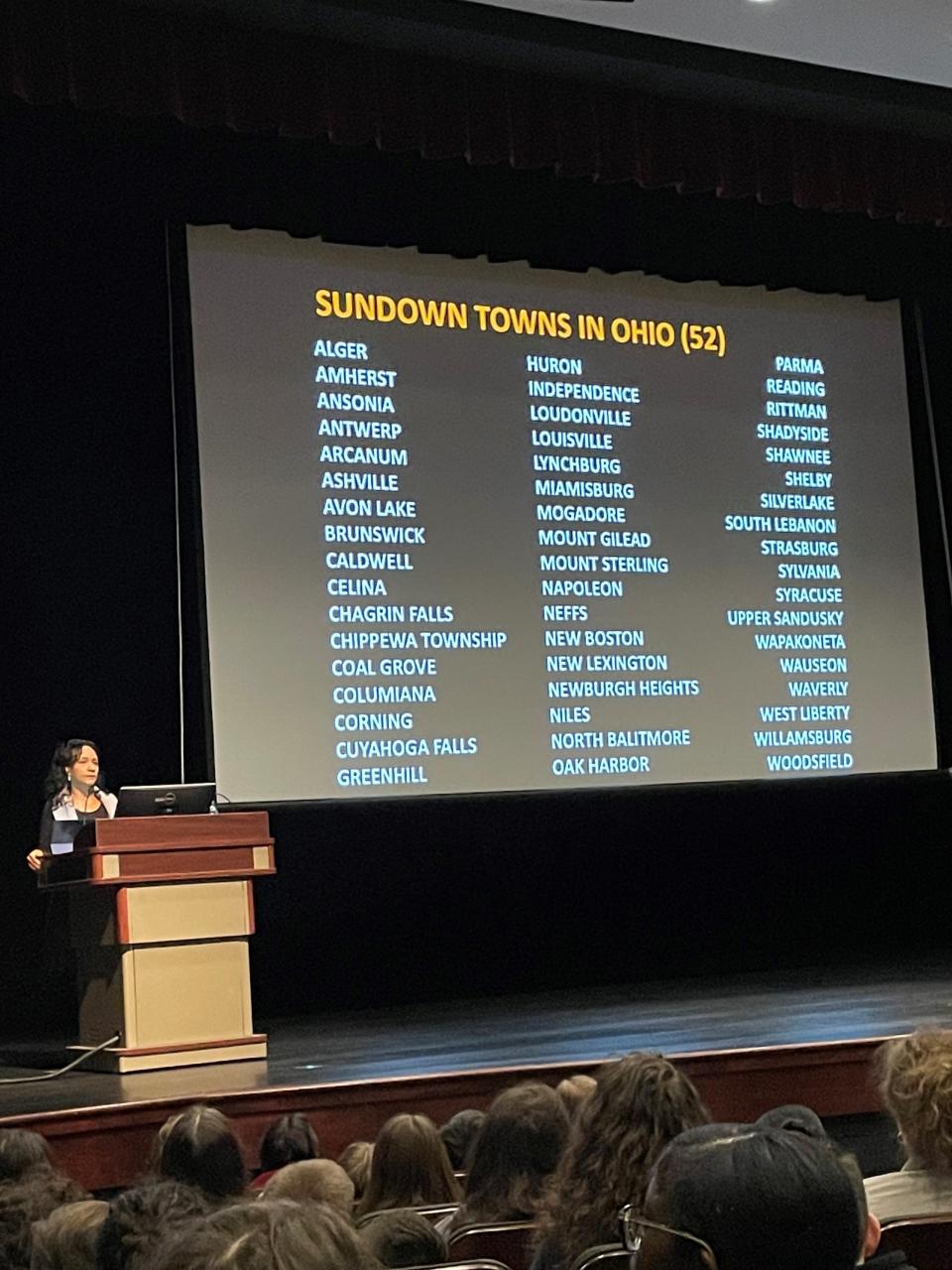Author Taylor highlights 'Green Book' in Black history talk at Ohio State Newark
- Oops!Something went wrong.Please try again later.
NEWARK ― Not long after award-winning author and photographer Candacy Taylor had finished speaking Wednesday morning at Ohio State University-Newark's Reese Center, the hands started to go up.
Over 400 students and staff from Newark City Schools attended the talk about her book, Overground Railroad: The Green Book and the Roots of Black Travel in America, and they had plenty to ask. The Works: Ohio Center for History, Art, and Technology, and community sponsors helped bring Taylor there as part of Black History Month.

They were allotted a half hour for questions, but it could have been two hours. Many of the students have been reading her book, in which Taylor traveled the country, visiting, photographing, and interviewing people from The Green Book sites. Victor Green, a Harlem postman and travel writer, published Green Book from 1936-66, during a period of widespread discrimination across the country, and it provided a list of hotels, boarding houses, taverns, restaurants, barber shops, beauty salons, funeral homes, service stations and other establishments that served African-Americans.
Dr. Brianna Johnson, Director of Diversity, Equity and Inclusion for OSU-Newark and Central Ohio Technical College, was excited to see the Newark students' response.
"Based on the number of questions, it was great to see them so engaged," she said. "This gave students and the community a chance to see a period of history that made a profound impact, from someone who has touched the artifacts that are so close to American history."
The presentation also had an impact on Newark School Board member Warren Weber, an Air Force veteran who traveled the country with his family. "It brought back a lot of memories," he said.
Taylor, from Columbus and now living in New York City, earned fellowships at Harvard and the Schomburg Center for Research in Black Culture in Harlem, and her projects have been commissioned and funded by numerous organizations, including the Library of Congress and National Geographic. Her work has been featured in over 80 media outlets including The Atlantic, CBS Sunday Morning, The Economist, The Guardian UK, The Los Angeles Times, The New York Times, The New Yorker, Newsweek, PBS Newshour, Time Magazine and the Wall Street Journal.
She is the curator and content specialist for the exhibition, The Negro Motorist Green Book, which is being toured by the Smithsonian Institution Traveling Exhibition Service (SITES) through 2025, and her passion for the project was evident on Wednesday. Taylor drove 90,000 miles across the country, mostly on two-lane roads, to visit Green Book sites, and it has taken her about eight years to write her book. She was worried for her safety in some places, and often had to take photos from her car.
"I didn't know about Green Book until 2013, and a lot of people didn't know about it," Taylor said. "So I felt the story had to be told. There were just under 900 of these places, and not were all downtrodden sites. There was also Disneyland, Macy's and the Waldorf-Astoria. Only about 20% of these buildings are still standing, and about 3-to-5% are still operating. It's important to preserve them. They symbolize Black ingenuity and strength. They changed the shape on how America functioned." It has taken seven years to get all of them into a data base.
Taylor reflected on the Second Great Migration, from 1930-80, during which six million African-Americans were fleeing racial terror. There were "Sundown towns," where basically, Black people were banned after 6 p.m. ranging from 1890 to 1968, when the Fair Housing Act was put into law.
"People think there were many in the South, but most were clustered in the Midwest," she said. There were 52 in Ohio, including Waverly, which rang a bell at 6 p.m. Taylor traveled Route 66 across the middle of the country, where there are 90 counties, and over half of them had "Sundown towns."
She noted that it was important to hear the stories, about the risks Black folks took just to travel.
"Black men who drive nice cars, they would carry chaffeur hats, in case they were pulled over," Taylor said. "They drove at night to avoid trouble. This was a time when even Coca-Cola machines were segregated."
She's hopeful her project will have positive influence on racial equality, with the history and insight it provided, but admittedly, Taylor remains skeptical.
"It was a spiritual journey, but also perplexing," she said. "I'm not real confident we'll find the perfect union, where we treat everyone the same. Fifty years from now, unfortunately, we'll probably still be talking about the same things."
One audience member urged her to carry on.
"The Macon Hotel area in Columbus, which was one of the sites you mentioned, is undergoing a transformation," they said. "Stay encouraged."
In addition to The Works, other community supporters for Taylor's visit included the Licking County Foundation, OSU-Newark, COTC, Explore Licking County and Ohio History Connection. The event was livestreamed through YouTube to the Ohio History Center in Columbus
Her visit is part of a community collaboration to offer historical and cultural programming during Black History Month. Other partners include the NAACP and Licking County Library who assisted in planning and consulting on programming.
The library’s downtown Newark location has provided a book group about Taylor’s book, along with history profiles on Daniel Merritt Guy, the first Black man to be nominated for public office in Licking County; and a profile on Gertrude Dorsey Brown, a talented author of short fiction.
dweidig@gannett.com
740-704-7973
Twitter: @grover5675
Instagram: @dfweidig
This article originally appeared on Newark Advocate: Author highlights 'Green Book' in Black history talk at OSU-N

